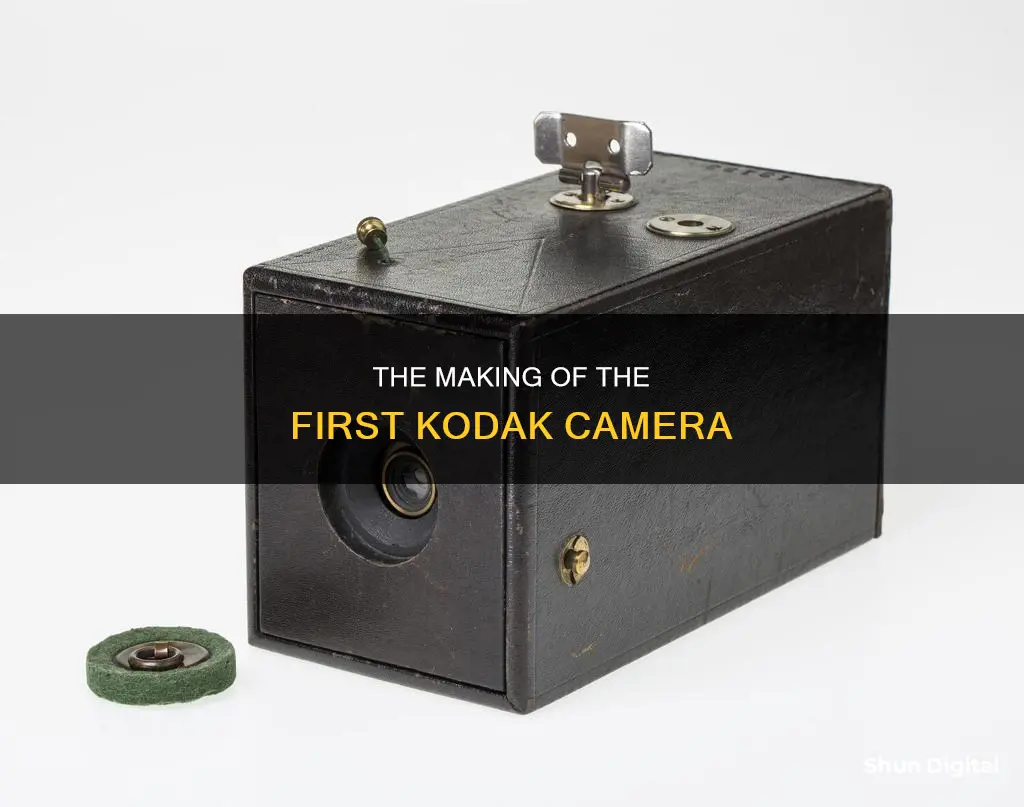
The first Kodak camera was invented by George Eastman and placed on the market in 1888. It was a simple handheld box camera with a fixed-focus lens and no viewfinder. Eastman received a patent for the camera's shutter and a trademark for the Kodak name in September 1888. The camera was an immediate success and made photography accessible to amateur photographers by simplifying the apparatus and processing the film for the consumer.
What You'll Learn

George Eastman's invention
In 1888, George Eastman invented the first simple handheld camera, the Kodak, which was an immediate triumph. Eastman's real genius lay in his marketing strategy. By simplifying the apparatus and even processing the film for the consumer, he made photography accessible to millions of casual amateurs. The camera was an instant success with the public and launched a fad of amateur photography.
Eastman's journey to this invention began in 1880 when he became one of the first to successfully manufacture dry plates commercially in the United States. The following year, he and Henry Strong formed a partnership called the Eastman Dry Plate Company. In 1884, the company was re-incorporated as the Eastman Dry Plate and Film Company. Eastman's interest now turned to replacing glass plates altogether with a new roll film process. In 1885, he patented the first practical film roll holder, which would allow dry plate cameras to store multiple exposures in a camera simultaneously. That same year, he also patented a form of paper film he called "American film".
In 1888, the Kodak camera was patented by Eastman. It was a box camera with a fixed-focus lens on the front and no viewfinder. Instead, two V-shaped silhouettes at the top aided in aiming in the direction of the subject. The camera came pre-loaded with a 100-exposure roll of film that used paper negatives instead of glass plates to take circular pictures, each roughly 2.5 inches (6 cm) in diameter. The $25 camera could be mailed to Eastman's headquarters in Rochester, New York, with $10 for processing. The camera would be returned with prints, negatives, and a new roll of film.
The Kodak was designed with the novice photographer in mind. To use the camera, the photographer simply armed the shutter by pulling up on the string (located on the front right of the camera), pointed the camera at the subject, and then pressed the shutter release. These steps were clearly explained in the camera’s instruction manual and were used to promote the ease of the camera along with the slogan, "You press the button, we do the rest."
Activating Patrol Mode on Hikvision Cameras: A Step-by-Step Guide
You may want to see also

Kodak's launch in 1888
The Kodak camera was launched in the summer of 1888, marking a pivotal moment in the history of photography. The brainchild of George Eastman, the Kodak was the first successful roll-film hand camera, designed with the novice photographer in mind. Eastman's goal was to make photography as accessible and convenient as writing with a pencil, and the launch of the Kodak camera brought him a step closer to realising this vision.
The Kodak camera was a box-style camera that came preloaded with a 100-exposure roll of flexible film. This was a significant departure from earlier cameras that relied on glass-plate negatives for each exposure. Eastman's innovation eliminated the need for cumbersome and complicated processes associated with traditional photography, making it possible for anyone to capture moments and memories with ease. The camera's simple mechanism required no adjustments or prior photographic knowledge. Users simply had to arm the shutter by pulling a string, point the camera at the desired subject, and press the shutter release button.
The Kodak camera produced circular snapshots with a diameter of approximately 2.5 inches. After capturing 100 pictures, users could mail the camera back to the Kodak factory in Rochester, New York, for developing and printing. This service cost $10, and the camera would be returned with a fresh roll of film, negatives, and mounted prints. The entire process aligned with Eastman's famous slogan, "You press the button, we do the rest."
The launch of the Kodak camera in 1888 was an immediate triumph. Eastman received a patent for the camera's shutter and trademarked the name "Kodak" in the same year. The camera's accessibility and ease of use sparked a craze for amateur photography, with snapshot photography becoming a national trend within a few years. The success of the Kodak camera led to the company being renamed the Eastman Kodak Company in 1892, and it went on to become one of the world's largest film and camera manufacturers, shaping the future of photography and visual storytelling.
Unlocking Cyberpunk's Camera Mode: A Step-by-Step Guide
You may want to see also

The camera's design
The first Kodak camera, introduced in 1888, was a simple handheld box camera. It was designed with the novice photographer in mind, requiring no adjustments or prior photographic knowledge. The camera was pre-loaded with a 100-exposure roll of flexible film, which produced circular images 2 5/8" in diameter. The camera had no viewfinder; instead, it featured two V-shaped lines on the top of the camera leather to aid in aiming the camera at the subject.
The Kodak camera featured a rotating barrel shutter that was unique to this model. The shutter was set by pulling up a string on the top of the camera and was released by pushing a button on the side. After taking a photograph, a key on top of the camera was used to wind the film onto the next frame. The camera also included an instruction manual that explained the steps for taking a photograph, emphasising the ease of use with the slogan, "You press the button, we do the rest."
The camera was sold for $25, which included the camera loaded with film and a leather carrying case. After finishing the roll, the consumer would mail the camera back to the factory to have the prints made. The entire process, from taking photographs to receiving the final prints, made photography accessible to a wide range of people, defining a new style of photography that was informal, personal, and fun.
Live Mode Camera: Is it Available on the Galaxy S8?
You may want to see also

The company's growth
The first Kodak camera, invented by George Eastman, was placed on the market in 1888. It was a simple handheld box camera containing a 100-exposure roll of film that used paper negatives instead of glass plates to take circular pictures, each roughly 2.5 inches (6 cm) in diameter. The camera was sold for $25 with the film sealed inside. After the last negative was exposed, consumers sent the entire camera to one of the Eastman factories, where the roll was processed and printed. This ease of use and accessibility to amateur photographers helped the camera gain immediate success with the public and launched a fad of amateur photography.
Following the success of the first Kodak camera, the Eastman Dry Plate and Film Company was renamed the Eastman Kodak Company in 1892. Over the next few decades, the company continued to innovate and expand, becoming one of the world's largest film and camera manufacturers.
In the 1890s and early 1900s, Kodak grew rapidly, outmaneuvering competitors through a combination of innovation, acquisitions, and exclusive contracts. The company focused on control of the film market, recognising that film would return more profit than the cameras themselves. This business model, known as the razor and blades model, remained largely unchanged for several decades.
To accommodate its growth, Kodak constructed larger facilities, including the Kodak Park in Rochester, which began construction in 1890. The company also expanded internationally, opening shops and factories in Europe, Australia, and later in other parts of the world.
Kodak continued to innovate and improve its products, introducing new camera models such as the Brownie in 1900 and the Instamatic in the 1960s, which became some of the most popular camera models of the 20th century. The company also diversified its offerings, selling materials for the printing industry, health imaging, and more.
By the 1920s, Kodak had become one of the largest American companies in the photographic industry, and by 1927, it had achieved a virtual monopoly in the United States. The company's dominance continued throughout most of the 20th century, with heavy investment in research and development, leading to numerous technological innovations.
Kodak's success was built on its ability to make photography accessible to the masses, revolutionising the industry and solidifying its place as a leader in imaging technology.
Battery Cells for Camera Drones: How Many Do You Need?
You may want to see also

Kodak's decline
Kodaks Decline
- Competition from Fujifilm: Kodak faced increasing competition from Japanese competitor Fujifilm, which entered the U.S. market in the 1980s with lower-priced film and supplies. Fujifilm's aggressive marketing and price-cutting strategies took a significant market share from Kodak, especially in the professional market with specialty films.
- Digital Disruption: The shift from film to digital photography disrupted Kodak's core business. Despite developing the first self-contained digital camera, Kodak struggled with the transition. The company's revenues and profits declined as digital cameras and cell phones replaced traditional film cameras.
- Strategic Missteps: Kodak made several strategic missteps, such as attempting to diversify into chemicals and instant cameras, which resulted in large losses. The company also cut benefits and laid off employees to save money, affecting its competitiveness.
- Failure to Adapt: Kodak failed to adapt to changing market demands and consumer trends. The company's business model remained largely unchanged from the 1930s to the 1970s, causing it to fall behind rivals in innovation. Kodak was slow to invest heavily in digital technology, and its digital cameras were soon undercut by cheaper Asian competitors.
- Financial Troubles: Kodak's financial situation deteriorated, with declining revenues and profits. The company filed for Chapter 11 bankruptcy protection in 2012 and underwent restructuring, shedding liabilities and exiting several businesses.
- Loss of Market Share: Kodak's market share declined due to the increasing popularity of digital photography and competition from Fujifilm. By the early 2000s, Kodak's revenues and net earnings had dropped significantly, and its market share continued to erode.
- Patent Litigation: As Kodak's financial troubles mounted, the company turned to patent litigation to generate revenue. However, this strategy provided only temporary relief and did not address the underlying issues affecting the company's performance.
- Impact on Rochester: Kodak's decline had a significant negative impact on the Rochester area, contributing to high poverty rates as jobs were replaced with lower-paying ones. Kodak's departure left a gap in the local economy that other sectors struggled to fill.
Samsung Galaxy S8: Night Mode Camera Feature Explained
You may want to see also







